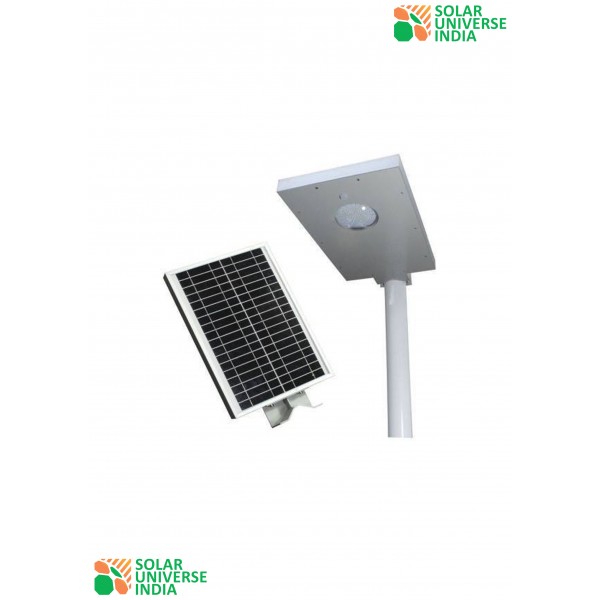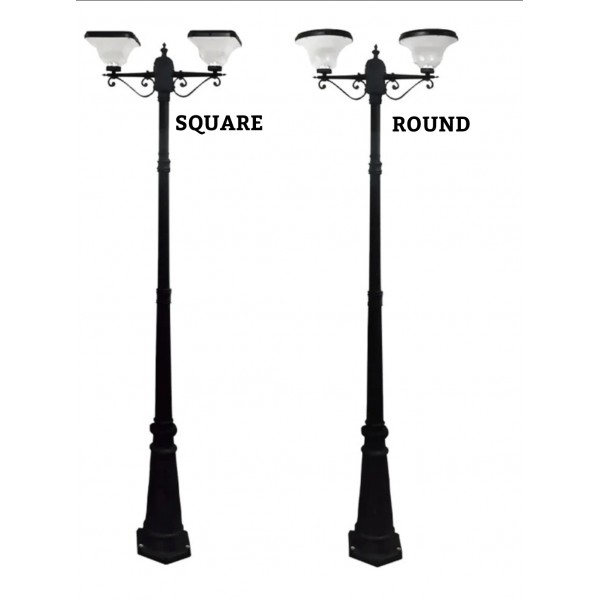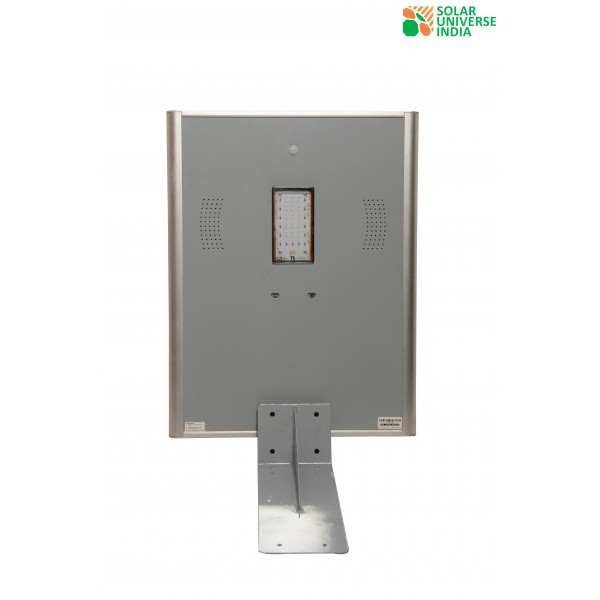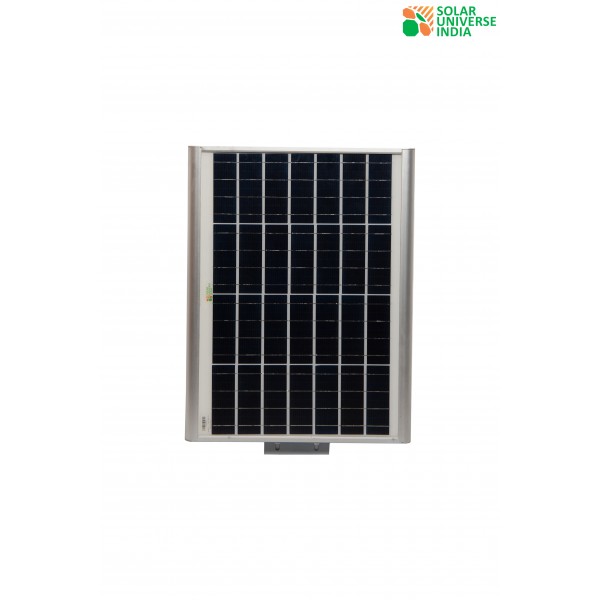Definition of Solar Street Light
A solar street light is an effective outdoor lighting source operated through the use of solar energy. Solar Street Light is a recent technological innovation for lighting solutions, powered by photovoltaic (PV) panels. The PV panels having rechargeable batteries are fixed on the lighting structure or in the pole to provide power supply to the solar LED street light or street lamp during the night.
The solar panels or PV panels are designed in such a way to feed natural light source or sunlight. This enables the street light to provide sufficient light during the night, or cloudy days even for a couple of days when the sun’s energy is not available. People are switching to solar street lights these days due to several causes such as lesser maintenance, environment-friendly, eliminates your carbon footprints contribution, and handy solutions to lighting problems. Even solar street lights in India is also popular only because of these reasons. SolarClue is an online platform where people can find several solar street light manufacturers to purchase their preferred street light at different pricing portfolios.
Components of Solar Street Light
Solar Street Light is manufactured using five components, such as Solar Panel, Lighting Fixture, Rechargeable Battery, Controller, and Pole.
Solar Panel or PV Panel: - It is the main component of the solar street light that helps to convert solar energy into electricity. The solar panel is divided into two different types, mono-crystalline, and poly-crystalline.
Lighting Fixture: - Lighting fixtures like LED is another component used in solar street light that helps in providing much higher Lumens (total amount of visible light from a lamp or light source) with lower consumption of power. The primary benefit of an LED fixture is to consume energy consumption of about 50% lesser than the HPS fixture.
Rechargeable Battery: - It is used in collecting electricity from solar panels and stores it during the day time to provide power supply to the fixture during the night. Gel Cell Deep Cycle Battery and Lead Acid Battery are two different types of rechargeable batteries.
Controller: - It is also a crucial element of a solar street light. A controller is a vital part that decides when to switch on or off the charging battery and lighting system.
Pole: - It is an essential part of a solar street lighting system. Pole is built-in supporting the fixtures, panels, and batteries as they get mounted on the top of the pole.
Types of Solar Street Lights
There is a total of four types of solar street lights available in the market.
1. Off-Grid Split Type Solar Street Light System
2. Grid-Tie Solar Street Light System (Grid-Tie Single Inverter, Grid-Tie Micro-Inverter)
3. Solar & Wind Hybrid Solar Street Light System
4. All-In-One Solar Street Light System
Working Principle or Functionalities of Solar Street Light
The optimum functionality of solar street light is to offering lightning solutions at night for several streets and by using natural energy called sunlight. A solar street light is generally functioned by PV solar cells that convert the energy of sunlight into electrical energy by the use of the semiconductor material of the device. This entire process of energy conversion (called a photovoltaic effect or Photovoltaic cells) is used in storing solar power in batteries during the day and provides proper light at night with illumination reduced to 10lux.
After this, the solar cells board is used to open the circuit voltage of about 4.5V. Then the charging and discharging controller is used to protect the battery and detects movement of the voltage value. This entire process is the working principle of solar street lights.
Advantages of Solar Street Light
• The operation cost is inexpensive as the solar street light independently works
• Known as a pollution-free source of producing electricity to offer lighting solutions
• It is used not by utilizing any external wires hence, negligible chances of occurrence of accidents happened
• It has lower chances of overheating
• Easy accessibility of smart street light in remote areas because the parts of this lighting system carry easily.
The solar power system is a complete setup ideal for home and commercial places, which helps in producing electricity by utilizing solar energy (sunlight). A solar power system is made up of solar panel (which absorbs sunlight), inverter (which converts DC electricity into AC), mounting structure (which holds the panels in place), batteries (helps to store the extra power generated), grid box and balance of systems (wires, nuts).
In other words, a solar power system is composed of numerous photovoltaic (PV) panels, inverter (a Dc to AC power converter), and a rack system that holds the PV panels in place (solar PV panels on the roofs of homes and businesses generate clean electricity by converting the energy in sunlight). Solar power system comes in 1 kW, 3kW, 5kW, 10kW, and several other capacities. It is a good choice for those who want to reduce their electric bills and their carbon footprint.
As the prices of electricity are rising, people across the world looking for renewable energy sources for their power, or electricity needs. Solar energy has now become a popular renewable energy source because of its cost-effective price and improving efficacies. And for this reason, the solar system for home has stepped forward in the market with its great features.
On-Grid Solar System
The on-grid solar system or Grid-tied solar system is a kind of solar system that generates current only when the utility power grid is available. In other words, the on-grid system is a solar system that generally works with the grid. Saving the electricity bill is the prime purpose of installing an on-grid solar system.
The on-grid solar power system consists of Solar Photovoltaic modules / Panels, DC-AC grid-tied solar Inverter and Installation Kit (includes mounting structures, ACDB, DCDB, A.C, D.C wire, Connectors, lighting arrestor, earthling cables).
The foremost benefit of installing an on-grid solar system for home is a cost-effective solution, which helps to pay for such systems by offsetting utility bills in 3-8 yrs. In addition to this, there are some other advantages of the on-grid solar system, including:
• Zero electricity bills (consumer has to pay only for the surplus electricity he consumes because the solar power system is connected to the grid only).
• Easy maintenance (on-grid solar power system has the least number of parts along with simple installation or fitting).
• Passive income generation (with connection to the grid, the consumer can charge for the surplus electricity he has generated, which is not only beneficial in reducing your electricity bills but also helps to avail the cost benefits for the excess electricity generated).
• Provides you with at least 5 years' payback time and free electricity for the next 20 years.
Moreover, the on-grid solar system is simple enough that anyone can install it by himself. The on-grid solar system price is affordable that anyone can purchase it by investing at pocket-friendly prices.
Off-Grid Solar System
The off-grid solar system is a popular type of solar power system with backup, which works both day and night. During the day time, solar panel charges the battery to run the home appliances with the use of DC, and at night or cloudy weather days when the sunlight is not available, inverter runs your home appliances (Air Conditioners, Cooler, Television and submersible pump, etc.) using the battery power or AC current.
The off-grid solar system allows you to store your solar power in batteries for future use, especially when the power grid goes down or if you are not on the grid. Hybrid systems are capable of providing power to balance the grid power whenever the sun shines, which enable to send excess power to the grid for later use.
The utmost benefit of using an off-grid solar system is to provide power for your critical loads when the power grid becomes down. An off-grid system is more prevalent that comes with a power backup and works independently of the grid.
Benefits of using off-grid solar system:
• Works as a self-sustainable system that can work independently and not depending on the grid
• Helps in avoiding power outages, which may occur without any warning
• Helps in generating enough power that can be stored and used at night or when the power grid is down
• Reduces electricity costs (fossil fuels are still the world's primary energy source)
• Easier installation facilities
• Best alternative for remote areas where there is no power access from the grid
• Keeps the environment clean and green
Hybrid Solar System
The hybrid solar system is another type of solar power system that generates power or electricity supply in the same way as the common grid-tie solar system does. The only difference of a hybrid solar system is that such a system uses batteries to store energy for later usage. A hybrid solar system can operate as backup power, and it is possible because of the ability to use the maximum amount of stored energy (uses this energy during a blackout which is similar to a UPS system).
The term ‘hybrid solar system’ refers to a combination of battery storage and solar systems in which the off-grid system is connected to the electricity grid. Hybrid solar system is classified into three types such as All-in-one Hybrid Inverter (which contains a battery inverter/charger and solar inverter together with clever controls), All-in-one Inverter with no Back-up (works like a grid feed solar inverter which enables storage of solar energy in the battery system for the self-use), and All-in-one Inverter with Back-up (used as both an on-grid or off-grid inverter, which has a great backup capability).
Advantages of hybrid solar system:
• Allows consumers to store excess solar power or low cost (off-peak) electricity
• Allows using of solar energy during the evening times (known as self-use or load-shifting)
• Facilitates with backup power capability that helps to provide power during a blackout or grid outage like a UPS function
• Enables advanced management of electricity power and energy independence
• Reduces the power consumption from the grid
Solar Accessories
Solar accessories are important for all your small and large-scale power generation requirements. The main accessories used in solar power system installation are Batteries, Solar Charge Controllers, Off-Grid Solar Panels, and Solar Battery Enclosures.
Solar batteries: Solar batteries for home energy systems are made using lithium-ion batteries (lighter and more compact than lead-acid batteries) rather than lead-acid, and saltwater. Lead-acid batteries are used in off-grid energy systems that have a relatively short life, and lower DoD than other battery types. Saltwater batteries (newcomer in the home energy storage industry) don’t contain heavy metals as compared to other home energy storage options. Solar batteries are considered the best in terms of battery capacity & power ratings, depth of discharge (DoD), round-trip efficiency, warranty, and finest manufacturing facilities.
Solar charge controllers: Solar charge controllers are a voltage regulator to keep batteries from overcharging and also regulates the current coming from the solar panels going to the battery. A solar charge controller is categorized into two different technologies, PWM and MPPT. An MPPT charge controller is more expensive than a PWM charge controller but worth buying it even if expending more money.
Off-grid solar panels: This particular solar panel consists of a battery, charge controller, grid box, inverter, mounting structure, and balance of systems. Off-grid solar panels can store enough sunlight during the day, and use the excess power generated in the night.
Solar battery enclosures: Solar battery enclosures are used to keep your batteries safe from weather, and safe from theft. It is attributed with feature locking mechanisms that protect unauthorized people against possible electrical dangers if they happen to be tampering with your equipment. Battery enclosures for solar systems are pole-mounted or ground-mounted and suitable for indoor and outdoor applications.
Solar light is a recently advanced lighting technology to produce light by using natural energy coming from the sun. What is solar light? It is a device developed in such a way to store and provide solar energy by using its particular source (sunlight). Solar lights are used in solar panels or photovoltaic cells to collect solar thermal energy and transforms it into lighting.
Information about solar light
Solar lights generally use solar energy (sunlight) during the day time to charge its inbuilt battery, which is capable of running the light during the night. Electricity saving is the first and foremost benefit of solar light or solar charging light as it helps consumers to save their electricity costs. When it comes to electricity-saving, solar lighting systems are the best affordable solutions to avail as they eliminate the costs of trenching and wiring. Solar light prices in India vary from one model to another, and one type to one more.
Solar is the long way to go especially, while the power supply is unavailable, or too expensive. This is the best answer to the question of how the solar system works. Nowadays, solar lights have gathered huge attention even at the national level due to their tremendous attributes. The topmost features of solar lights are environment-friendly, reasonably priced, and energy-efficient. And the availability of a solar light online facility is a very good option for the buyers that allow them to select their desired model just seating at their place instead of visiting the shop.
Application Areas of Solar Lights
Solar lights are considered the first-ever option in providing natural energy that helps in serving varied requirements, be it a back yard, garden area, hospital campus, or a large parking lot. Apart from these, solar charging lights also cater to the necessities of some more application areas, which are as follows:
• Lighting for highways or roadways
• Lighting for parks and playgrounds
• Solar lighting for industrial and commercial purposes
• Outdoor lights for security commitments and many more areas
Types of Solar Lights
Solar lights are categorized into varied types, which include:
• Solar Street Light / Solar Panel Street Light / Solar Street Lighting System
• Solar Garden Light / Led Garden Light / Solar Lamp for Garden
• Solar Lighting System
• Solar Emergency Light
Solar Street Light: Solar street light is ideally used for street lighting in roadways of urban as well as rural areas. The solar street lighting system is controlled by adequate battery storage backup that facilitates to operate the light for 10 to 11 hours a day. The particular system operates by an automatic ON/OFF time switch.
The estimated price for the solar panel street light is around 24,000 rupees. But the solar street light price varies based on its capacity, models, and brands. The solar street lighting system or solar street light consists of a solar photovoltaic module, battery box, lamp post and lamp with charge controller. Moreover, solar street light is popular these days due to its easy installation, eco-friendliness, electricity-saving, and low maintenance cost.
Solar Garden Lights: Solar garden lights or outdoor garden lights are manufactured in such a way to decorate and enhance the ambiance of garden spaces. However, LED garden lights or solar LED garden lights or solar lamps for gardens don’t give good brightness, but they are excellent for enlightening plants in the garden at night. Solar garden lights’ price is affordable that anyone can purchase.
Solar Lighting System: The solar lighting system is an eco-friendly device that runs lights by using batteries charged over the usage of the solar photovoltaic panel. This particular lighting system consists of solar panels, LED lamp, battery, charge controller, and inverter.
Solar Emergency Light: A solar emergency light is a battery-backed lighting device functioned by solar energy and designed in such a way to switch on automatically to provide power supply when a building experiences a power outage. The solar emergency lighting system is battery-operated light and tied into the building’s power grid permanently, which helps to provide light solutions independently by using solar light.
An emergency light is a battery-backed lighting device that switches on automatically when a building experiences a power outage. Moreover, solar emergency lights are ideal in new commercial houses and high occupancy residential buildings, such as college dormitories, apartments, and hotels.
Advantages of Using Solar Lights
There are several benefits of using solar lighting systems or solar lights. Some of them are listed below:
1. Natural Power Supply
Solar lighting is an alternative option of a traditional lighting system using no power at all from the electric grid. The solar lights are completely power-driven by solar energy, hence considered as one of the world’s leading renewable energy technologies. The solar light batteries used in solar lights are recyclable.
2. Environment-Friendly
Solar lights are environment-friendly because they do play an important role to decrease carbon imprint by producing energy from non-renewable energy sources or sunlight. Therefore, solar lights are the best option to decrease the problems caused by the exhaustion of our planet’s resources.
3. Unlimited Source
Solar energy comes to solar light is everlasting. As long as you live in a place where there is more or less sunlight, which means one can use the source of solar thermal energy infinitely. And, in this case, solar lights are the optimum choice to avail lights.
4. Low-Cost Installation
The installation cost of solar lights is very less as compared to others, running in traditional grid power. Because all wiring or cabling placed at the top of the lighting system are useful for the process of installations. Furthermore, solar lights operate through low voltage that keeps the lighting system safe for installation and maintenance.
5. Maintenance Free
The entire solar charging light is maintenance-free as the lifespan of its battery continues five to seven years. And the durability of other components of solar lights lasts up to 30+ years, which are free from maintenance.
6. Zero Electricity Bills
Users can save their electrical power bills once they start utilizing solar lights. However, buyers are required to invest one time while they purchase the solar lighting system.
7. Available in a wide range of styles and patterns
Solar lighting system or solar light is available in numerous styles, types, sizes, shapes, and designs. It is made in such a way to serve functional purposes and aesthetically and visually attractive. There are so many options available in the market now that one can choose any solar light as per his or her requirements.
In addition to these, there are also some other advantages of a solar lighting system. Solar lighting can be installed in environmentally sensitive areas, where network infrastructure or any electrical connections are not accessible. Solar lights are even useful for the situation when power failure caused due to extreme weather events such as storms or cyclones. It is considered the best substitute of the electrical network. Moreover, solar lighting systems due to their sophisticated battery technology can provide shine or light for five days continuously once they get recharged fully with the help of sun rays.
Are you looking for a solar
inverter, solar lights, and solar water heater online? Worry not! Solarclue.com
is there to help you provide many online deals in PAN India. Buy Premier solar
energy-based products with exciting offers, best deals, free shipping. If your
home is situated in Ichalkaranji, Maharashtra, you can even book your order
online on SolarClue.













